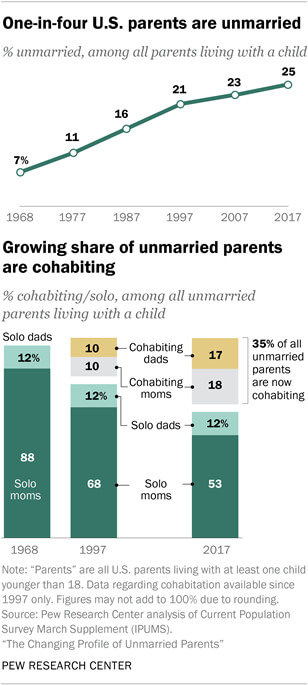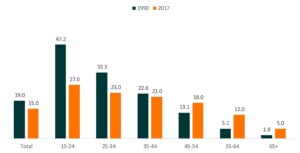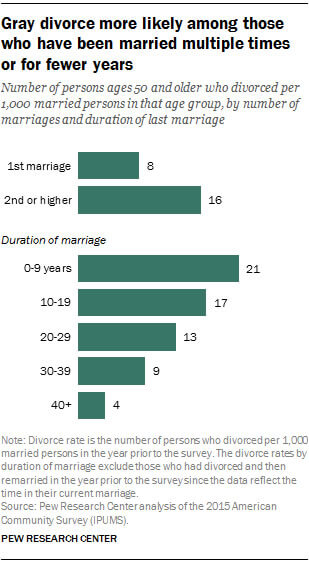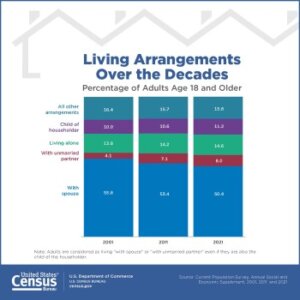Divorce Rates Statistics and Trends for 2024
What is the current trend in divorce? What is the current divorce rate? What is the current divorce rate 2024? What is the #1 divorce cause? How many 40 year marriages end in divorce? How common is divorce after 50?
By Miles Mason, Sr. For comment, see his media page.
Divorce Rates Statistics and Trends for 2024
In searching divorce rate statistics for trends to keep an eye on in 2024, the first indicator has to do with people’s living arrangements.
Adult Children Living with Parents
According to the U.S. Census Bureau’s 2023 estimates from its annual America’s Families and Living Arrangements,[i] 56% of adults aged 18 to 24 lived in their parental home while only 16% of adults aged 25 to 34 lived in their parents’ home. Among opposite-sex married couples in 2023, 23% of children under 15 had a stay-at-home mother while only 1% lived with a stay-at-home father. In 2023, 71.6% of family groups were opposite-sex married couples.[ii] As for single adults (age 15 and older), 34% had never been married.
According to the Bureau’s 2021 estimates,[iii] only half of all adults (50.4%) lived with a spouse, a 2% decrease over one decade from 52.4% in 2011.
In 2021, 14.6% of adults 18 and older lived alone as compared to 14.2% in 2011 and 13.6% in 2001. In 2021 that 14.6% represented about 37 million adults – 28% of all U.S. households[iv] – living in one-person households compared with about 33 million in 2011.
2024 Divorce Trend #1: Number of adults living with a spouse will continue to decrease below the 2021 rate of 50.4%. Number of adults living alone will continue to increase above the 2021 rate of 14.6%.
CHART SOURCE:
Cohabiting Unmarried Parents
In 2017, 35% of unmarried parents were cohabiting, compare that to only 20% in 1997. The percentage of cohabiting unmarried parents with at least one child under the age of 18 living with them has been increasing. In 2007, 70.7% of children under age 18 lived with two parents of whom only 2.9% were unmarried. In 2023, 71.1% of children under 18 lived with two parents of whom 4.4% were unmarried.[v]

CHART SOURCE:
2024 Divorce Trend #2: The number of cohabiting parents with children under age 18 living with them will increase above the 2023 rate of 4.4%.
Divorce Statistics Heading into 2024
What is the current divorce rate?
Following the CDC’s reporting of marriage and divorce statistics, the U.S. divorce rate has steadily decreased over the past two-plus decades right alongside the marriage rate.
In 2000, the marriage rate was 8.2 per 1,000 total population while the divorce rate (divorces and annulments) was 4.0 per 1,000 total population.[vii]
In 2010, the marriage rate was 6.8 while the divorce rate was 3.6 per total population. This is a significant decline in the number of marriages with a corresponding decline in divorces.
In 2019, the marriage rate was 6.1 while the divorce rate was 2.7 per 1,000 total population.
In 2021, the marriage rate was 6.0 per 1,000 total population while the divorce rate was 2.5. For every 6.0 people who get married, 2.5 will be divorced – this puts the 2021 crude divorce rate at 42%.
What is the current divorce rate 2023?
The divorce rate in 2023 was at or near the 2021 crude rate of 2.5 per 1,000 (California, Hawaii, Indiana, Minnesota, and New Mexico data not included in the provisional 2021 rate). For charts for this data, see
2024 Divorce Trend #3: Marriage rate will continue to fall below the 2021 rate of 6.0 per 1,000. Divorce rate will continue to fall below the current rate of 2.5 per 1,000.
Divorce Statistics into 2024 By Age
The rate of divorce tends to decline as the age of the married spouses increases.[viii] Generally, the older the couple and longer the marriage, the less likely they are to divorce.
The 2019 data shows adults between the ages of 25 and 39 had a divorce rate of 24 per 1,000 people currently married. The 2019 divorce rate for adults between 40 and 49 was 21 per 1,000 currently married. And the 2019 divorce rate for adults age 50 and older was 10 per 1,000.[ix]
What age group has the highest divorce rate?

GRAPH SOURCE:
In 2021, Census Bureau data indicated the median age at first marriage was age 30.4 for men and age 28.6 for women.[xi] The trend has been an increase in age at first marriage for both men and women. Historically with first marriages, women are younger than men.
GRAPH SOURCE :
How common is divorce after 50?
Of all divorcing adults in the U.S., 36% are 50 years of age or older. Of all age groups, the only increasing divorce rate is among those 65 and older.[xii]
Of adults 55 to 64 years of age who were ever divorced, the divorce rate is 43%. For those aged 65 to 74, the divorce rate is 39%. For adults ages 75 and older, the divorce rate is 24%.[xiii]
The rate of divorce for those 50 and older has more than doubled since the 1990s.[xiv] Furthermore, divorce among those 50 and older is more likely for persons married multiple times before or married for fewer years.[xv]
How many 40 year marriages end in divorce?

CHART SOURCE:
2024 Divorce Trend #4: Divorce rate for individuals 65 and to 74 will continue to rise above 39%.
In what year of marriage is divorce most likely?
Two periods in a marriage may have a greater frequency of divorce. The first two years of a marriage is believed to be the high-risk period for divorce. While years 3 through 4 have an average risk of divorce, years 5 through 8 mark the next high-risk period. Most first marriages that end in divorce do so in just under 8 years. By contrast, second marriages ending in divorce have a duration of about 7 years. A relatively low risk period follows – years 9 through 15. An average risk of divorce is believed to exist from year 15 through 20.[xvii]
2024 Divorce Trend #5: High risk periods of divorce will continue to be marriage years 1-2 and 5-8. Average risk periods for divorce will continue to be marriage years 3-4 and 15-20. Low risk periods for divorce will continue to be marriage years 9-15.
What is the #1 divorce cause?
The number one reason given for why the marriage failed is “lack of commitment.”[xviii] This is followed by “infidelity” and then “excessive conflict.”[xix] After “married too young” came financial issues and the “lack of family support” (understandable as the number one reason given for getting married is “financial security”).[xx] Near the top of the list of reasons leading to the breakdown of a marriage are “lack of compatibility” and “lack of intimacy.”
Divorce Rate in America 2024
The U.S. divorce rate peaked in 1979-1981 with 53% of all marriages ending with divorce (5.3 divorces per 1,000 people).[xxi] Much has changed since then.
Before Covid-19 restrictions hit the U.S. married population and the courts, the 2021 divorce rate was expected to be around 45% (as estimated). Delayed court proceedings and spouses maintaining the status quo during the pandemic likely reduced the number of divorce filings in 2020 and early 2021. Many legal professionals projected an increase in divorce filings by mid-2021, essentially making up for a Covid-19 slump. However, court backlogs from the pandemic resolved with a divorce rate normalized at 42% for 2021.[xxii]
Divorce Rate Trends in Tennessee
The population of Tennessee was estimated by the Census Bureau to be 7,126,489 on July 1, 2023.[xxiii] Tennessee’s projected 2024 population growth is 1.16% for a total population of 7,217,315 with a rank of 15 among the states. This represents a population growth since 2010 of 13.73%.[xxiv] State population growth for 2025 is projected to be around 7,179,307 with growth continuing through 2070 with a population of 9,429,399 projected.[xxv]
2024 Divorce Trend #8: Tennessee will continue to increase its total population above the current rate and exceed 7.5 Million by 2025.
According to the 2021 U.S. Census Bureau’s American Community Survey (ACS) regarding Tennessee, of the estimated 2,713,115 men 15 years of age and older, 50.8% are married, 3% are widowed, and 11.0% are divorced. Of the estimated 2,877,358 women 15 and older, 40.7% are married, 9.4% are widowed, and 13.3% are divorced.[xxvi]
Compare Tennessee Marriage Rate to Other States
2024 Marriage Rate By State
Tying with the State of Alaska, Tennessee has an estimated 49.2% married rate for 2024 as compared to Utah’s 55.8% (highest rate) and Louisiana’s 43.7% (lowest rate).[xxvii]
Tennessee is not among the top 10 marriage states for 2024. Instead, Tennessee comes in 25th alongside Alaska. Top 10 highest marriage states in 2024:[xxviii]
- Utah (55.8%)
- Idaho (54.9%)
- Wyoming (54.3%)
- Nebraska (52.7%)
- North Dakota (52.4%)
- Kansas (52.2%)
- Montana (52%)
- Iowa (51.9%)
- New Hampshire (51.8%)
- Minnesota (51.7%)
2024 Divorce Trend #9: Tennessee marriage rate will fall below the 2024 rate of 49.2% and will remain out of the top 10 states for marriage.
Compare Tennessee Divorce Rate to Other States
In 2021, Tennessee* tied Kentucky and Mississippi with a 3.3% divorce rate:[xxix]
- Nevada (4.2%)
- Oklahoma (3.8%)
- Wyoming (3.7%)
- Alabama (3.6%)
- Arkansas (3.6%)
- Florida (3.4%)
- Idaho (3.4%)
- Kentucky (3.3%)
- Mississippi (3.3%)
- Tennessee (3.3)
*Data are annual counts per 1000 women at least 15 years of age.
2024 Divorce Trend #10: Tennessee divorce rate will continue to fall below the 2021 rate of 3.3%, but will continue to rank among the top states for divorce.
In 2020, the percentage of Tennessee marriages by population was 51.1%. This placed Tennessee just below Alaska (51.2%) and just above Missouri (50.9%).[xxx] The projected 2024 marriage rate for Tennessee is 49.2%.[xxxi]
Marriage rates have been declining for three decades in most states, including Tennessee. In 2000 the marriage rate in Tennessee was 15.5 per 1,000 total population residing in the area. In 2019, the marriage rate was 7.5 per 1,000 total population residing in area – less than half the marriages in less than two decades.[xxxii] The 2021 marriage rate for Tennessee was up slightly with 7.6 per 1,000 total population,[xxxiii] but still well below the year 2000 rate.[xxxiv]
Fewer marriages translate to fewer divorces per total population residing in the area. In 2000, the Tennessee divorce rate was 5.9 per 1,000 total population in the area. In 2019, the divorce rate was 3.5 per 1,000 total population residing in area.[xxxv] In 2021, the divorce rate for Tennessee was 3.3 per 1,000 total population.[xxxvi]
2024 Divorce Trend #11: Tennessee marriage rate will continue to fall below the 2021 rate of 7.6 per 1,000. Tennessee divorce rate will continue to fall below the 2021 rate of 3.3 per 1,000.
Tennessee Divorce Rates by County
With Tennessee’s 22,359 total divorces in 2020, the 11 counties with highest divorce rates per 1,000 people that year were:[xxxvii]
- Madison (9.9)
- Tipton (8.2)
- Montgomery (6.9)
- Cumberland (5.3)
- McNairy (5.0)
- Scott (4.8)
- Warren (4.7)
- Hamblen (4.6)
- Claiborne, Grundy, Sevier (4.5)
These are the 10 Tennessee counties with the lowest divorce rates per 1,000 people (2020):
- Roane (0.6)
- Jackson (0.8)
- Meigs (1.1)
- Carroll, Marion (1.3)
- Chester (1.5)
- Shelby (1.6)
- Crockett (1.7)
- Lake (1.9)
- Hardeman (2.0)
2024 Tennessee Divorce Trend #12: Divorce rates in Tennessee counties Madison, Tipton, Montgomery, Cumberland, and McNairy will continue to rise above the 2021 rate of 3.3 per 1,000. Divorce rates in Roane, Jackson, Meigs, Carroll, and Marion will continue to fall below 3.3 per 1,000.
USA Divorce Rate Statistics
These are the national divorce rates by number of years of marriage:
- 20% of marriages end in the first 5 years.
- 32% end in the first 10 years.
- 48% of spouses who married before the age of 18 are likely to divorce within 10 years.[xxxviii]
- 25% of spouses over 25 years of age get divorced within 10 years.
2024 Divorce Trend #13: Divorce rates by years of marriage will continue at or below current rates of 20% ending in first 5 years, 32% ending in first 10 years, 48% ending in 10 years when married before age 18, and 25% ending in 10 years when married after age 25.
Divorce Rate for First and Second Marriages
The rate of divorce increases in relation to the number of times married. Those who remarry are 2.5 times more likely to divorce.[xxxix]
Divorce from first marriage: About 8 years is the average length of first marriages ending in divorce.[xl] This period represents a divorce rate of around 50%.
Divorce from second marriage: About 7 years is the average length of second marriages ending in divorce. This period represents a divorce rate of around 67%. The divorce rate for third marriages is around 75%.
2024 Divorce Trend #14: Divorce rates for persons who remarry will continue to rise above the current rate of 67% for second marriages and 75% for third marriages.
Divorce Rate in the World
Countries with the highest annual 2021 divorce rates per 1,000 people are:[xli]
- Maldives (5.52 divorces per 1,000 people)
- Kazakhstan (4.6)
- Russia (3.9)
- Belarus (3.5)
- China (3.2 based on 2018 data)
- Moldova (3.0)
- Ukraine (2.9)
- Lithuania (2.8)
- Cypress (2.6)
- S.A. (2.5)
2024 Divorce Trend #15: The U.S.A. divorce rate will continue to fall below the 2021 rate, but will continue to rank among those nations with the highest divorce rates.
Based on 2017-2020 data, countries with the lowest annual divorce rates are:
- India (0.01)
- Mozambique (0.04)
- Kenya (0.06)
- Zimbabwe (0.07)
- Sri Lanka (0.15)
- Vietnam (0.2)
- South Africa (0.4)
- Bosnia and Herzegovina (0.6)
- Malta (0.06)
- Columbia (0.7)
2024 Divorce Trend #16: Countries with divorce rates at or below the 2020 rate of 0.7 per 1,000 will continue to be the lowest in the world.
As useful as divorce statistics are in predicting future trends, they do not reflect the personal challenges and serious issues faced by each individual spouse. When considering divorce, seek legal advice from an experienced divorce attorney.
END NOTES:
[i]
[ii]
[iii] Living Arrangements Over the Decades, U.S. Census Bureau 2021, Current Pop. Survey, Annual Social and Economic Supplement, 2001, 2011, 2021 (released Nov. 29, 2021).
[iv]
[v]
[vi]
[vii]
[viii] Bowling Green State University, Nat’l Ctr. for Family & Marriage Research (NCFMR).
[ix] 35 Encouraging Stats on the Divorce Rate in America for 2023.
[x]
[xi]
[xii] Brown SL, Lin IF. The Graying of Divorce: A Half Century of Change. J Gerontol B Psychol Sci Soc Sci. 2022 Sep 1;77(9):1710-1720. doi: 10.1093/geronb/gbac057. PMID: 35385579; PMCID: PMC9434459.
[xiii]
[xiv] 69 Divorce Statistics 2020/2021: Age, Reasons & Impact on Children,
[xv] Led by Baby Boomers, divorce rates climb for America’s 50+ population, by R. Stepler, Pew Research Center.
[xvi]
[xvii] Which Year of Marriage is The Most Likely to End in Divorce? By J. Pease, The Kronzek Firm PLC.
[xviii]
[xix] 113 Divorce Statistics on the Divorce Rate in America (for 2023), The Hive Law;
[xx]
[xxi] How the divorce rate has changed over the last 150 years, by F. Olito, Business Insider,
[xxii] 2.5 divorces divided by 6.0 marriages = 0.416 or 42.%.
[xxiii]
[xxiv]
[xxv] TN State Data Center, Boyd Center for Business and Economic Research,
[xxvi]
[xxvii] Original source: U.S. Census 2021 ACS 5-Year Survey (Table S1201).
[xxviii]
[xxix]
[xxx]
[xxxi]
[xxxii]
[xxxiii] CDC/NCHS, Nat’l Vital Statistics System, Marriage rates by State: 1990, 1995, and 1999-2021.
[xxxiv]
[xxxv]
[xxxvi]
[xxxvii]
[xxxviii] Divorce Statistics: Over 115 Studies, Facts and Rates for 2024, Wilkinson & Finkbeiner,
[xxxix] 6 Divorce Trends That May Surprise You, by S. Pastore, Main Line Family Law Center,
[xl] Divorce Statistics: Over 115 Studies, Facts and Rates for 2024, Wilkinson & Finkbeiner,
[xli]







